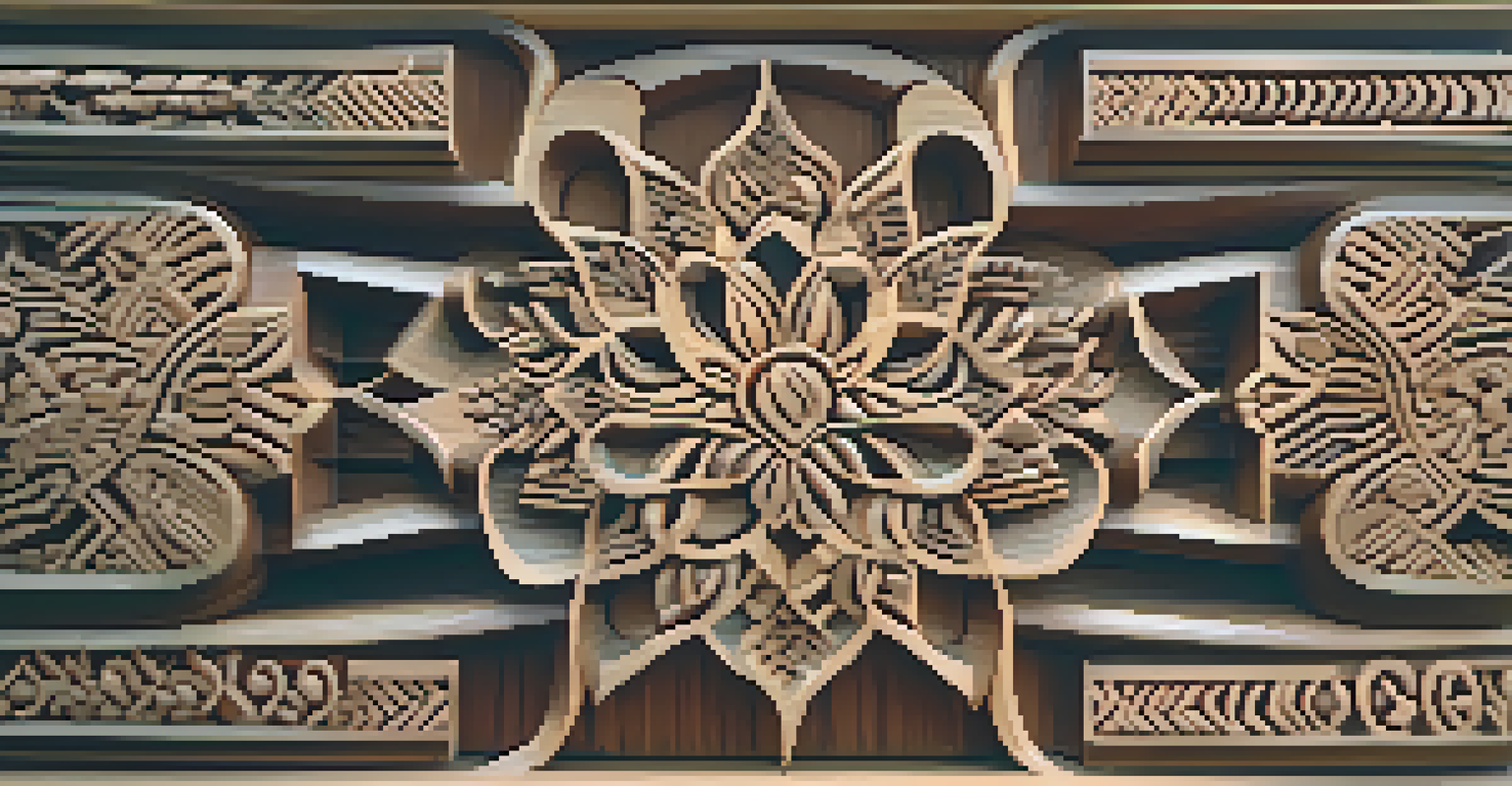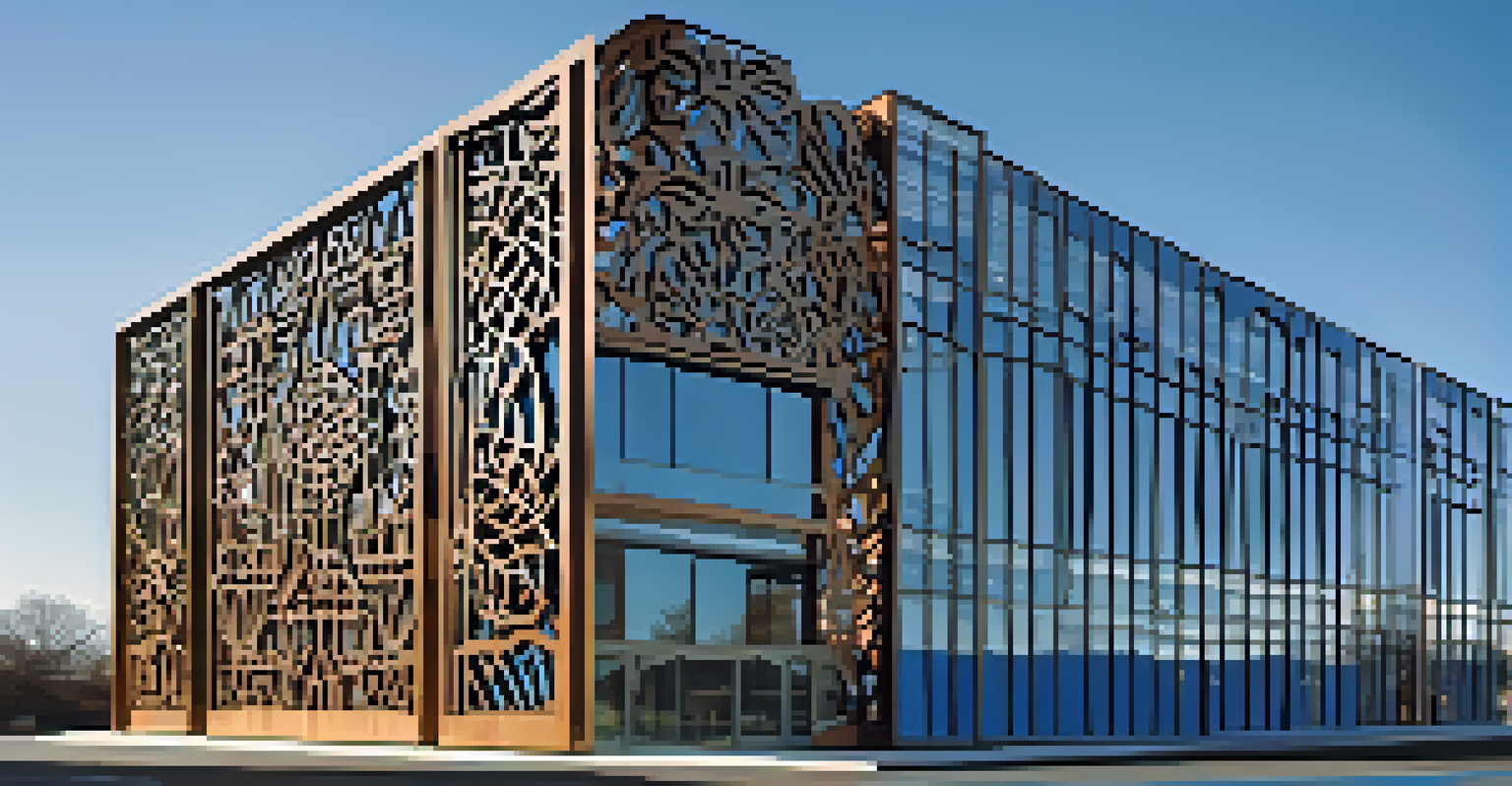Carvings as a Form of Architectural Identity

The Historical Significance of Carvings in Architecture
Carvings have been a fundamental aspect of architecture for centuries, often serving as a visual storytelling medium. From ancient temples to modern skyscrapers, these intricate designs reflect the cultural values and beliefs of the societies that created them. They not only embellish structures but also convey narratives that resonate with the community's identity.
Architecture is the learned game, correct and magnificent, of forms assembled in the light.
For instance, the ornate carvings of the Gothic cathedrals in Europe depict biblical scenes, illustrating the importance of religion in daily life during that era. Similarly, indigenous cultures often use carvings to express their connection to nature and ancestral stories, making each piece a vital part of their heritage. This historical context showcases how carvings contribute to a building’s significance beyond mere aesthetics.
In essence, understanding the historical significance of carvings allows us to appreciate the deeper meanings behind architectural choices, enriching our experience of these spaces. As we explore further, we will see how these artistic expressions continue to shape modern architecture.
Carvings as Cultural Expressions in Architecture
Every culture has its unique style of carving, reflecting its traditions, beliefs, and aesthetics. For example, the intricate wood carvings found in Balinese architecture showcase the island's deep-rooted spiritual beliefs and connection to nature. Similarly, Mexican architecture features vibrant stone carvings that narrate tales of mythology and history.

These cultural expressions not only enhance the visual appeal of buildings but also serve as a bridge connecting generations. They allow us to glimpse into the values and experiences of those who came before us, fostering a sense of belonging and continuity. Carvings thus become a vital part of a community’s identity, imbuing structures with stories and meaning.
Cultural Significance of Carvings
Carvings serve as vital cultural expressions, reflecting the traditions and values of communities throughout history.
As we dive deeper into the role of carvings, we’ll discover how they continue to influence contemporary architectural practices and maintain cultural relevance.
The Role of Carvings in Modern Architecture
In today’s architecture, carvings are experiencing a resurgence as designers seek to create spaces that resonate with cultural identity and history. Modern architects are increasingly incorporating traditional carving techniques into their designs, marrying the old with the new. This approach not only honors past craftsmanship but also adds depth to contemporary structures.
The details are not the details. They make the design.
For instance, the use of laser-cut technology has enabled architects to create intricate patterns that echo traditional designs while using modern materials. Such innovations allow for a fresh interpretation of carving, showcasing how it can adapt to current trends while still paying homage to its roots. This blending of styles often results in buildings that are both functional and visually striking.
The integration of carvings in modern architecture highlights the continuing relevance of this art form, ensuring that it evolves without losing its essence. As we explore further, we’ll see how these advancements are reshaping our understanding of architectural identity.
Environmental and Sustainable Aspects of Carvings
Incorporating carvings into architecture also opens up discussions about environmental sustainability and resourcefulness. Many architects are now using locally sourced materials that allow for traditional carving techniques, which can dramatically reduce the carbon footprint of a project. This practice not only respects the environment but also supports local artisans and craftspeople.
Moreover, carvings can enhance the sustainability of a building by providing natural ventilation and light, reducing the need for artificial heating and cooling. For example, intricately carved wooden screens can allow air to flow through while casting beautiful patterns of light and shadow inside. This blend of functionality and artistry exemplifies how carvings can contribute to eco-friendly building practices.
Modern Techniques Enhance Carvings
Contemporary architecture blends traditional carving techniques with modern technology, creating innovative designs that honor heritage.
As we delve deeper into the world of architectural identity, it becomes clear that carvings play a crucial role in promoting sustainability while enriching the aesthetic experience of buildings.
Carvings: A Dialogue Between Old and New Techniques
The evolution of carving techniques over time has led to a fascinating dialogue between traditional methods and modern technology. While hand-carving remains a cherished skill, advancements in tools and machinery have opened new avenues for creativity in architecture. This fusion allows architects to explore intricate designs that may have been difficult or impossible to achieve in the past.
Digital fabrication techniques, such as CNC (Computer Numerical Control) machining, enable precise carving on various materials, expanding the possibilities for architectural expression. However, many architects still emphasize the importance of traditional craftsmanship, often collaborating with skilled artisans to blend techniques. This balance between old and new creates unique architectural identities that honor heritage while embracing innovation.
As we continue to explore this intersection of techniques, it’s evident that the conversation surrounding carvings is as dynamic as the buildings themselves.
The Emotional Impact of Carvings in Architecture
Carvings in architecture do more than just serve a decorative purpose; they evoke emotions and set the tone for the spaces we inhabit. The intricate details and craftsmanship can inspire awe and admiration, creating a sense of connection between people and their environment. This emotional resonance is particularly evident in sacred spaces, where carvings often reflect themes of spirituality and transcendence.
For example, the delicate carvings found in places of worship can create an atmosphere that encourages reflection and contemplation. Similarly, public spaces adorned with carvings can foster a sense of community and belonging, inviting people to engage with their surroundings. These emotional connections remind us that architecture is not merely about functionality but also about the experiences it cultivates.
Preservation of Carvings is Crucial
Efforts to preserve intricate carvings are essential to maintain architectural heritage amid challenges from urban development and neglect.
As we move forward, we’ll examine how these emotional ties influence our appreciation for architectural identity and the role carvings play in shaping our experiences.
Preserving Carvings: Challenges and Future Directions
Despite their significance, preserving carvings poses challenges that architects and historians must address. Many structures with intricate carvings face threats from environmental factors, urban development, and neglect. As a result, initiatives aimed at restoration and conservation are crucial to maintaining these cultural treasures for future generations.
Moreover, the rise of digital documentation tools has revolutionized the preservation process, allowing for detailed records of carvings that can be used for restoration efforts. These technologies not only help in preserving the physical aspects but also in educating the public about the importance of these artworks. Engaging communities in preservation efforts fosters a collective responsibility towards architectural heritage.

Looking ahead, the challenge lies in balancing modernization with preservation, ensuring that the value of carvings continues to be recognized in an ever-evolving architectural landscape.